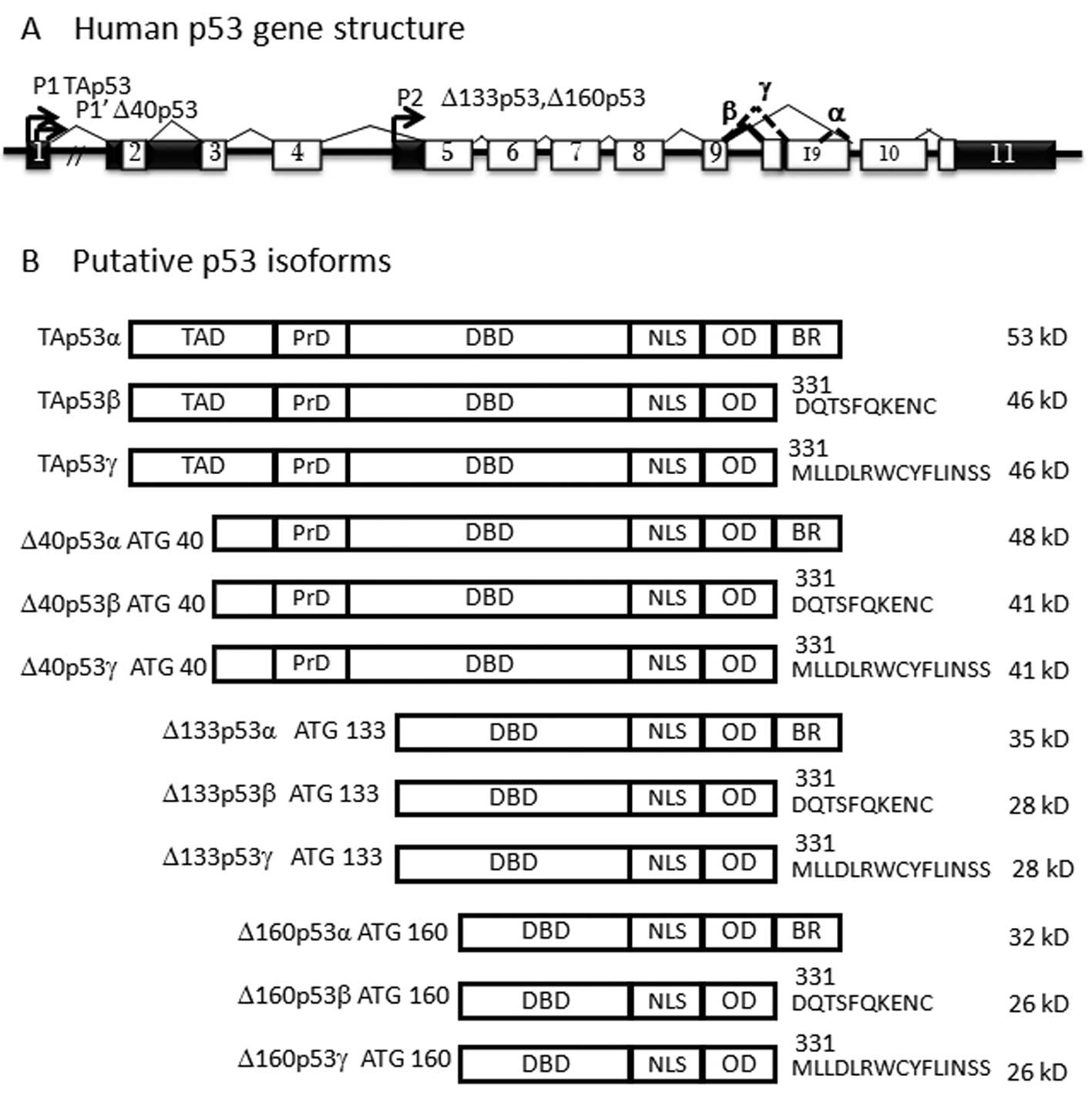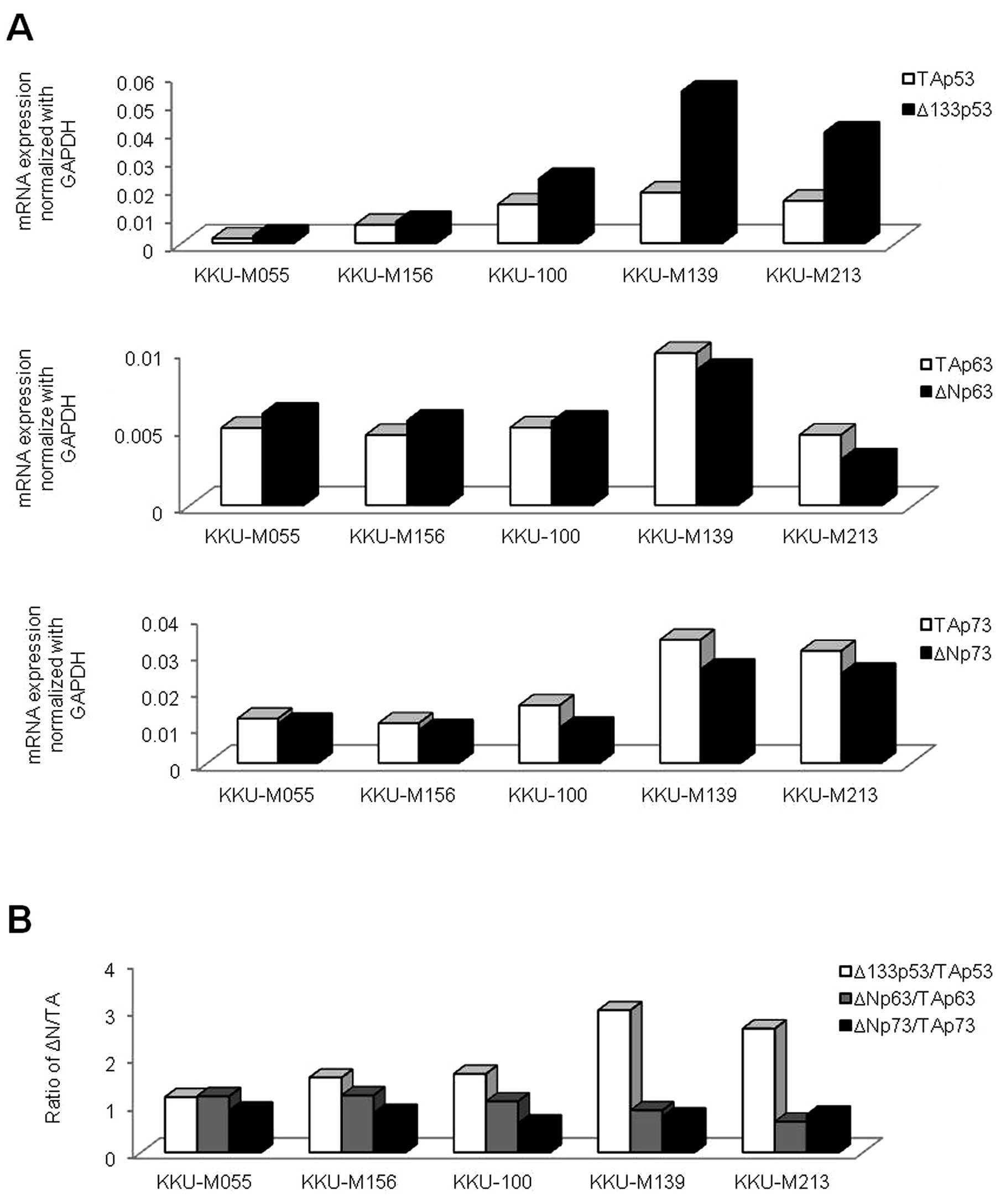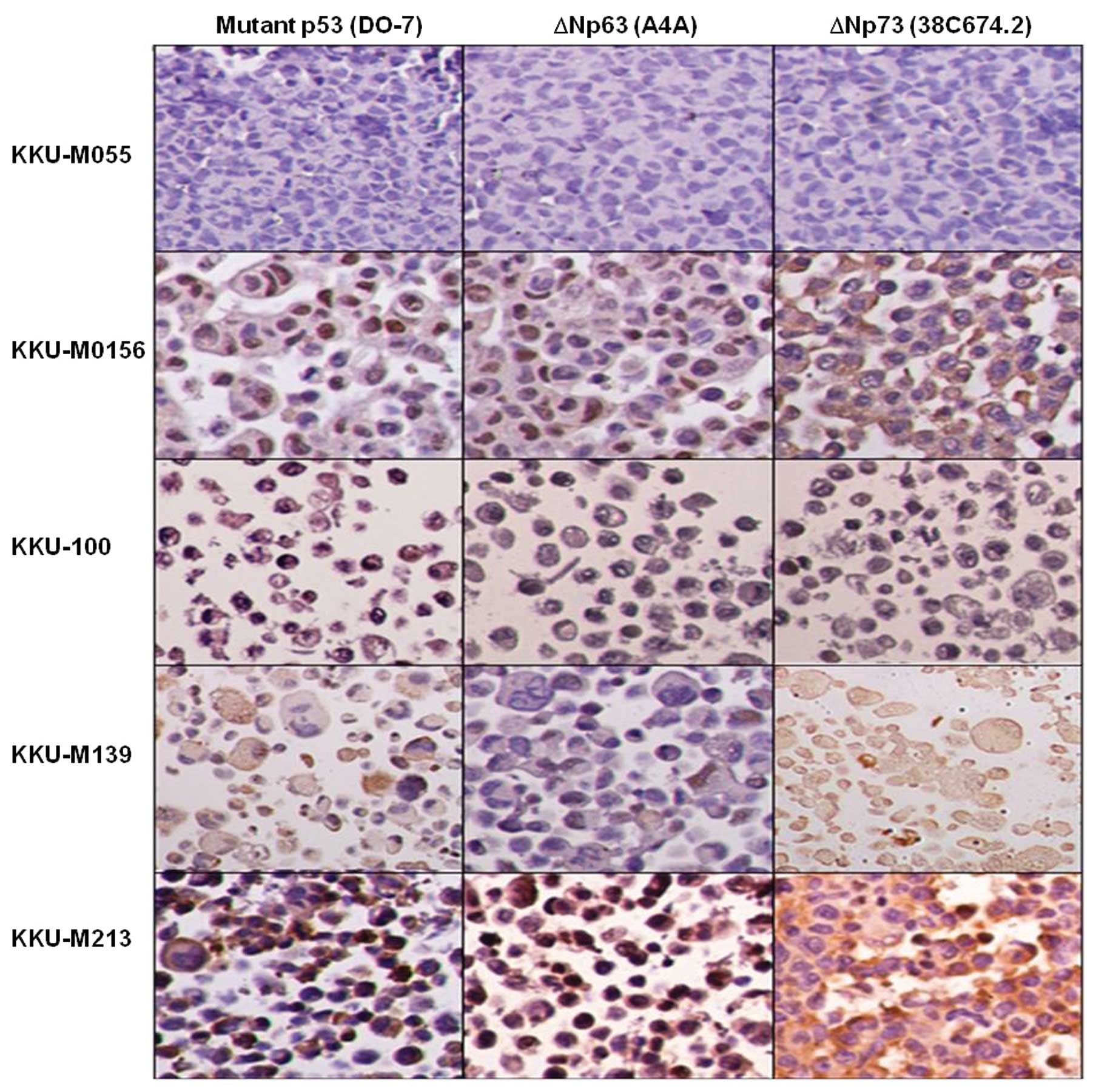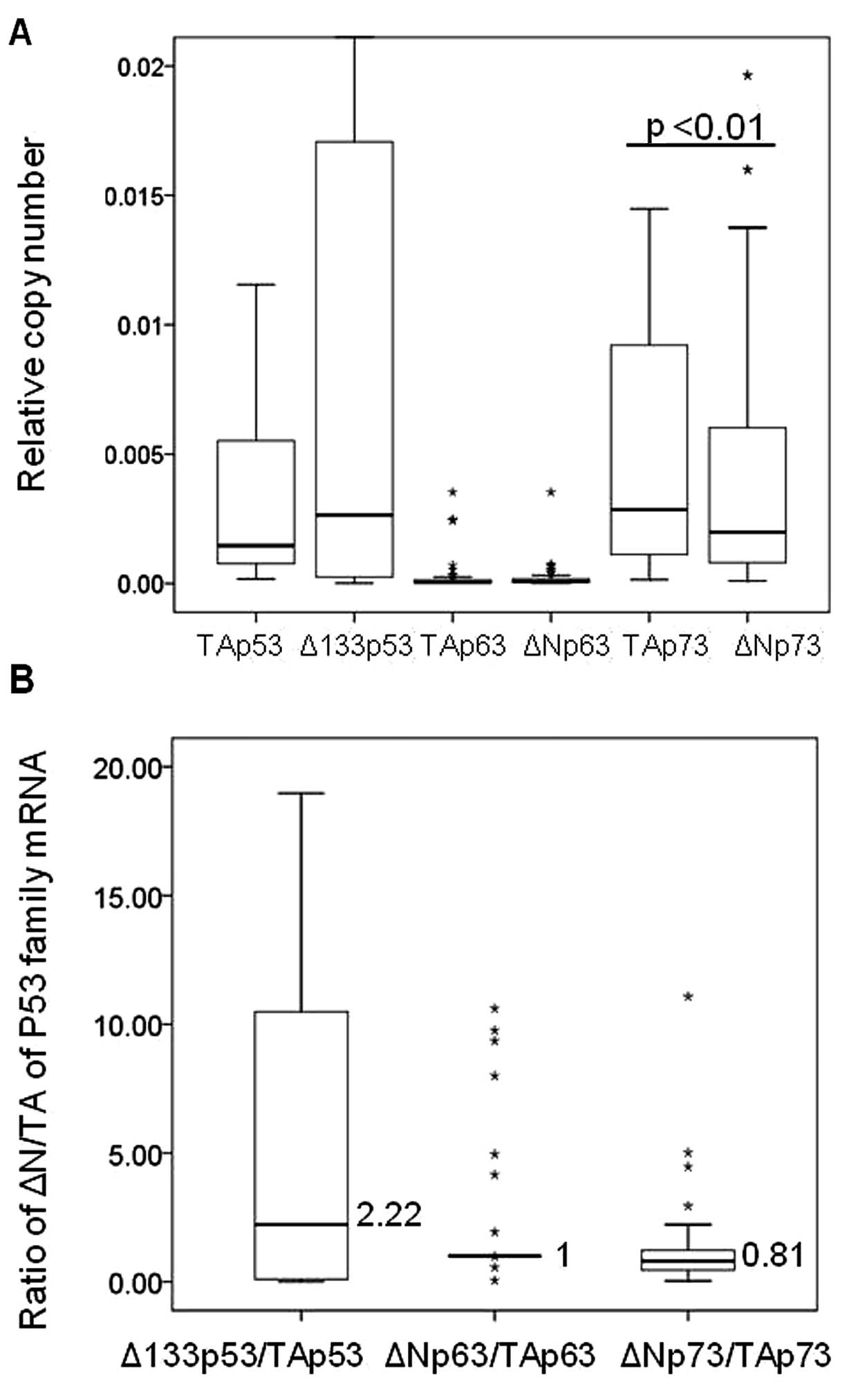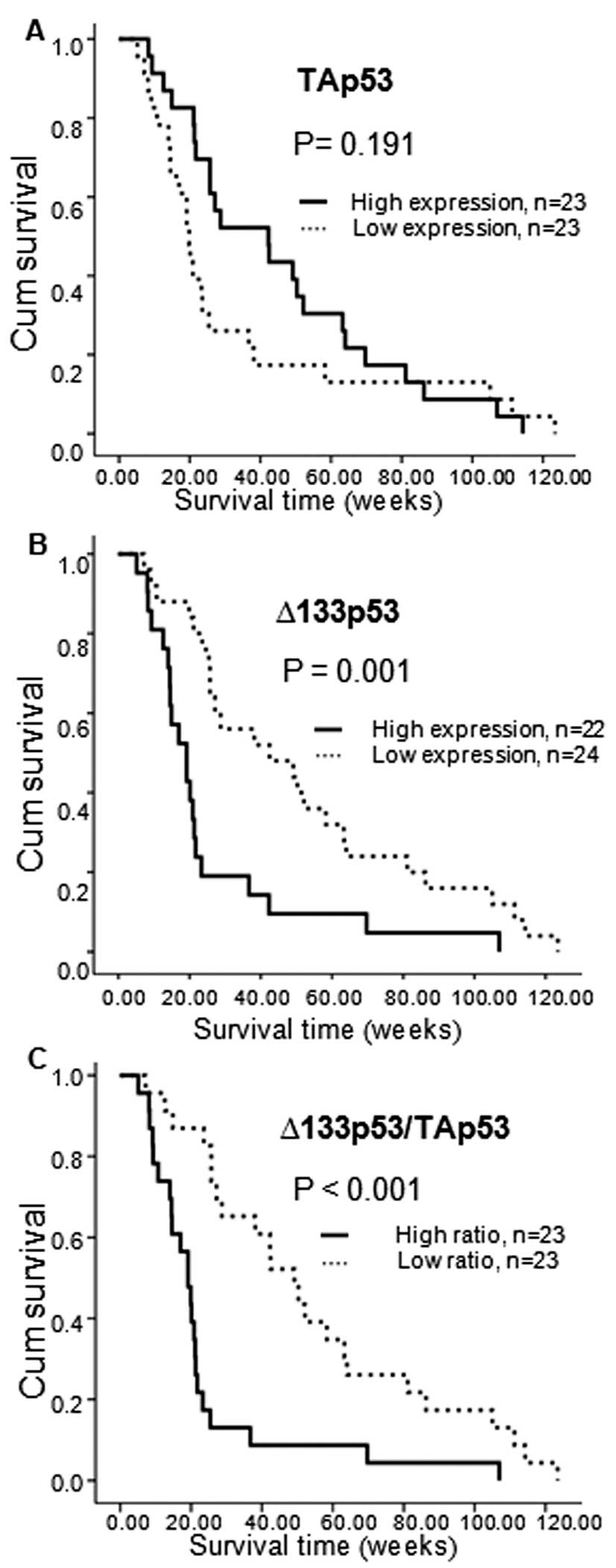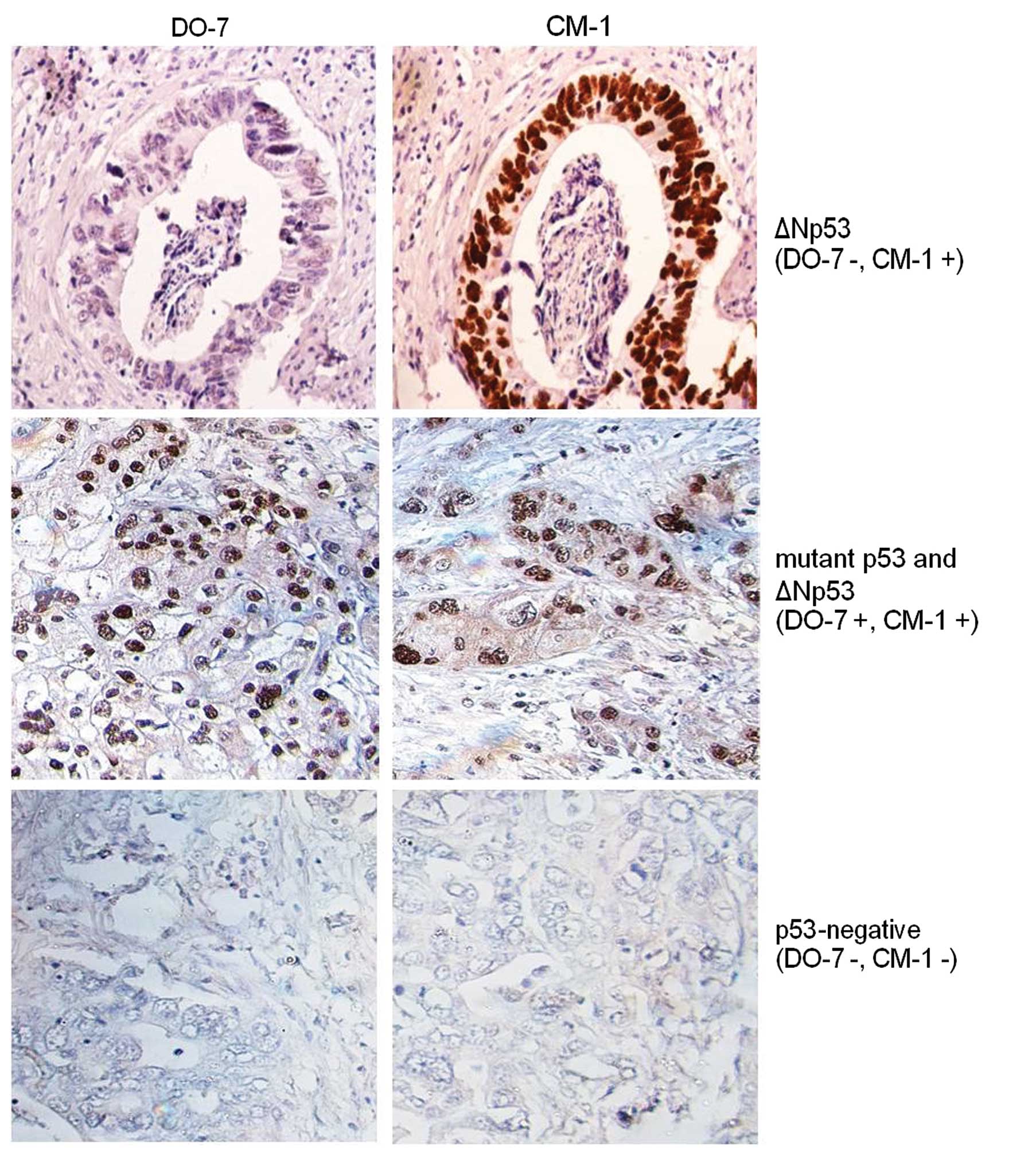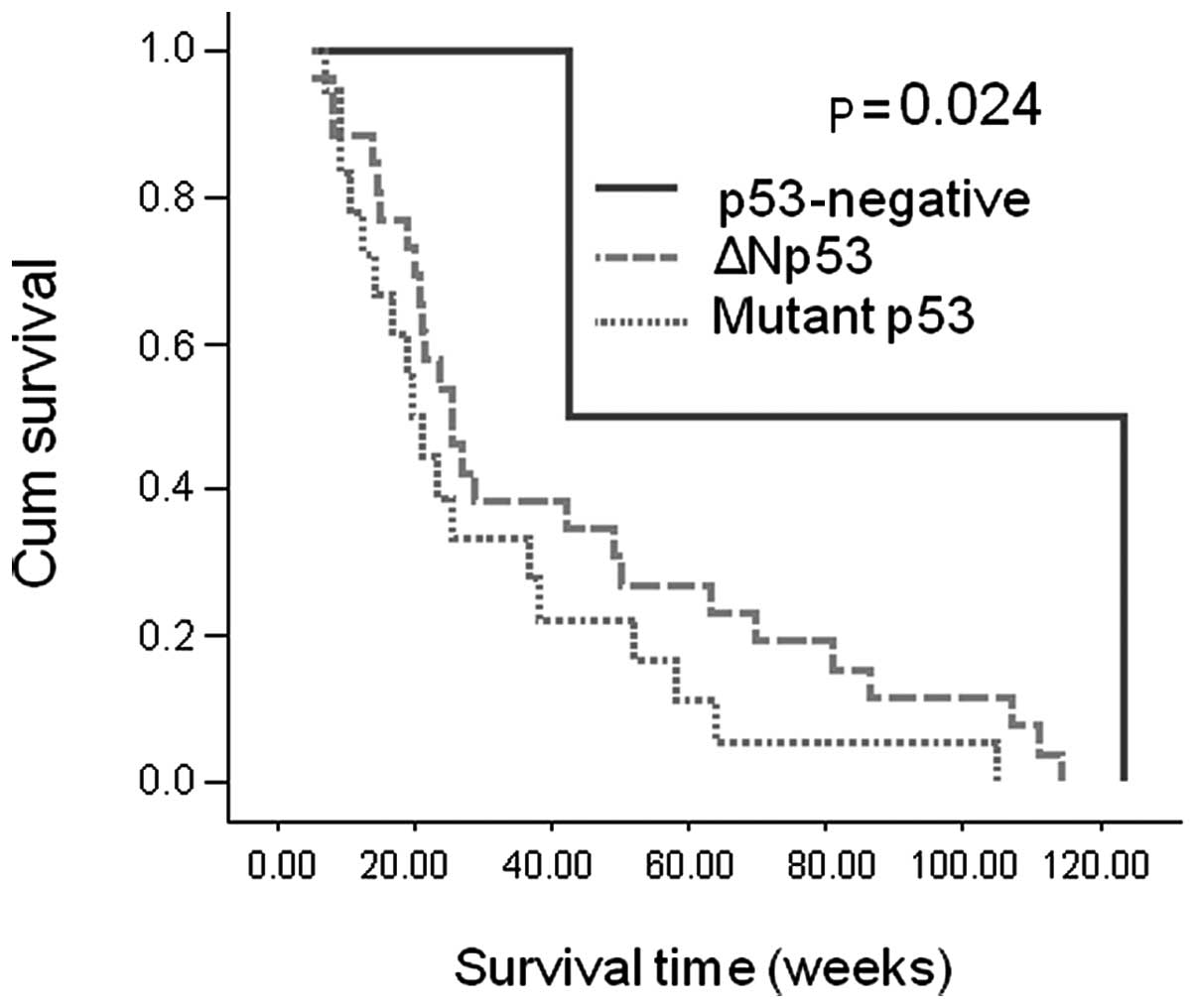Ratio disruption of the ∆133p53 and TAp53 isoform equilibrium correlates with poor clinical outcome in intrahepatic cholangiocarcinoma
- Authors:
- Published online on: February 8, 2013 https://doi.org/10.3892/ijo.2013.1818
- Pages: 1181-1188
Abstract
Introduction
Cholangiocarcinoma (CCA) is a malignant tumor which arises from bile duct epithelium. The northeastern region of Thailand, where liver fluke (Opisthorchis viverrini) infection is highly endemic, is reported to have the highest incidence rate of CCA worldwide. Chronic inflammation caused by liver fluke infestation leads to oxidative DNA damage and malignant transformation of the infected bile ducts (1). CCA is categorized according to its anatomic location as either intrahepatic (ICC) or extrahepatic (ECC) (2). The majority of CCA patients have a poor prognosis with a rather short mean overall survival (<30 weeks) due to the delayed diagnosis and different chemo-therapeutic responses, even at the same stages of the disease. To date, the availability of effective prognostic markers for predicting CCA progression and therapeutic outcome is limited.
p53 is a tumor suppressor gene that regulates cell cycle arrest and apoptosis. Two p53 protein family members, p63 and p73, have structures similar to the p53 protein and their transactivation, DNA binding and oligomerization domains enable them to promote cell cycle arrest and apoptosis (3–5). Several protein isoforms of p53, p63 and p73, generated by alternative splicing and promoter use (6), have been identified as the truncated proteins at the amino (N-; ΔNp53, ΔNp63 and ΔNp73 isoforms) and the carboxy (α, β and γ isoforms) termini. p53 is known to contain a second intronic promoter that generates the N-terminally truncated ΔN proteins, Δ133p53 (7) and Δ160p53 (8). Δ40p53 isoforms can also be generated by alternative splicing and alternative initiation of translation at intron 2 (7). The N-terminal domain is essential for the transactivation of target genes and the transactivating full-length isoforms or TAp53 are functionally distinguished from the transactivation-compromised ΔN isoforms that exhibit anti-apoptotic properties. Moreover, intron 9 can be spliced in 3 different ways, leading to the formation of α, β and γ isoforms. As a whole, the human p53 gene can express 12 different isoforms of the p53 protein (TAp53, TAp53β, TAp53γ, Δ133p53, Δ133p53β, Δ133p53γ, Δ40p53, Δ40p53β, Δ40p53γ, Δ160p53, Δ160p53β and Δ160p53γ), containing different domains of the protein, due to alternative splicing, alternative promoter use and alternative initiation of translation (Fig. 1). Deletion of their N-terminal domains not only contributes to the loss of transactivation but also interferes with the transactivation of their full-length isoforms (TAp53, TAp63 and TAp73), via tetramerization of the deleted isoform and the full-length protein (9). Therefore, overexpression of the ΔN isoform proteins can inactivate the full-length p53 family proteins (10–13).
A significant correlation has been reported between overexpression of ΔN isoforms and a poor prognosis in cervical, colon and ovarian cancer (10–12,14), but not in CCA. The incidence of p53 gene mutations in ICC is approximately 41.6% (15), while there has been no report of mutation in p73. However, promoter hypermethylation has been previously reported (16). Taken together, these data suggest a different mechanism underlying p53 inactivation. Thus, in this study, we aimed to examine the expression pattern of the ΔN and TA isoforms of the p53 family at the mRNA and protein levels. The correlation between the ΔN/TA p53 ratio and clinical outcome was investigated for its potential use as a prognostic marker in CCA.
Materials and methods
CCA samples and mRNA extraction
The CCA-derived cell lines, KKU-M055, KKU-M156, KKU-100, KKU-M139 and KKU-M213, established from CCA patients used in this study, were obtained from the Liver Fluke and Cholangiocarcinoma Research Center, Faculty of Medicine, Khon Kaen University, Khon Kaen, Thailand. The HeLa cell line was used as a positive control of p53 protein expression. All cell lines were maintained at 37°C in an atmosphere of 5% CO2 in DMEM high-glucose medium supplemented with 10% fetal bovine serum (FBS) and 1% penicillin-streptomycin. Cells were harvested when they reached 90% confluence and mRNA was extracted using the RNeasy Mini kit (Qiagen, Hilden, Germany). cDNA was prepared using the ImProm-II™ Reverse Transcription system (Promega, Madison, WI, USA) according to the manufacturer’s instructions and maintained at −20°C until use.
Resected ICC samples were collected from 48 patients who were admitted to Srinagarind Hospital, Faculty of Medicine, Khon Kaen University. This study was approved by the Ethics Committee of Khon Kaen University (HE52202) and written informed consent was obtained from each patient. Tissue samples were used for mRNA extraction, as mentioned above.
Primers designed for detection of ΔN and TA isoform transcripts using RT-PCR
All primers used to detect the mRNA expression of p53, p63 and p73 isoforms are summarized in Table I. Δ133p53 and TAp53 primers were designed in this study using free Primer3 software (available at: http://frodo.wi.mit.edu/cgi-bin/primer3/primer3_www.cgi). Each specific isoform product obtained from CCA cell lines was cloned into the pGEM®-T vector and verified by direct sequencing. The plasmid construct containing each isoform was used for setting a standard curve for the quantification of each isoform level using real-time RT-PCR.
Quantification of each isoform using real-time RT-PCR
The final volume of 25 μl of RT-PCR reaction contained 20 ng cDNA, 5 pmol of each primer and ABsolute™ QPCR SYBR®-Green Mix (Thermo Fisher Scientific, Loughborough, UK). The reaction was conducted on a Rotor-Gene 6000 thermal cycler (Qiagen) using PCR cycling conditions as follows: 94°C for 1 min, 57°C for 1 min and 72°C for 1 min for 40 cycles, with a final extension at 72°C for 10 min. All experiments were performed in triplicate. The absolute copy numbers were estimated from standard curves generated from a serial dilution of plasmid construct, ranging from 30 to 3×106 copies. The relative copy numbers were normalized to those of GAPDH. Coefficient of variation <15% and PCR efficiency >0.85 were considered acceptable.
Immunostaining of ΔN isoforms
CCA cell lines were pelleted and embedded in paraffin. The paraffin-embedded section (5 μm) of either tissue or cell pellet was deparaffinized and was used for antigen retrieval in boiled 0.01 M citrate buffer (pH 6.0). Endogenous peroxidase was inactivated with 100 μl of 3% H2O2. Non-specific binding was further blocked with blocking buffer containing phosphate-buffered saline with Tween-20 (PBST), 30% casein and 5% FBS. Each isoform was detected with primary antibodies: p53: clone DO-7, epitope 1–45 aa (Dako, Glostrup, Denmark) and clone CM-1, epitope located in DNA-binding domain (Signet, Emeryville, CA, USA); ΔNp63: clone 4A4, epitope 1–205 aa (Dako); and ΔNp73: clone 38c674.2, epitope 2–13 aa (Imgenex, San Diego, CA, USA). Proteins were detected using the EnVision system (Dako). The slides were counterstained with hematoxylin. Positive staining was observed as brown color in the nuclei and graded as positive when the percentage of positive cells was >10%, according to a previous study (18). The mutant p53 was defined when staining was positive for DO-7 and CM-1, while Δ133p53 was positive only for CM-1
Western blot analysis
Protein was prepared from CCA tissues and cell lines using TRIzol (Invitrogen, Paisley, UK) and fractionated on 15% SDS-polyacrylamide gels. The transferred proteins were detected with 1:100 of CM-1 (Signet) as the primary antibody and peroxidase-labeled anti-rabbit (Abcam, Cambridge, UK) as the secondary antibody. Chemiluminescence was detected with the ECL Plus system (GE Healthcare, Chalfont St. Giles, UK).
Statistical analysis
The significance of isoform expression was analyzed using the Wilcoxon test. Survival was determined with the univariate and multivariate Cox regression models, Kaplan-Meier analysis and the log-rank test. Statistical analyses utilized SPSS for Windows, version 15.0 (SPSS Inc., Chicago, IL, USA). A p-value <0.05 was considered to indicate a statistically significant difference.
Results
Significant increase of ΔN and TAp53 isoforms in CCA cell lines
We examined p53 family isoform transcripts in CCA cell lines using real-time PCR. The mRNA levels of ΔN and TA isoforms of p53, p63 and p73 genes were plotted as a relative number to GAPDH (Fig. 2A). The expression of the p53 family was observed in all CCA cell lines, although to a different extent. Of note, only the Δ133p53/TAp53 expression ratio was markedly increased (>1.0) in all the CCA cell lines, compared to ΔNp63/TAp63 and ΔNp73/TAp73 (Fig. 2B). Therefore, we were particularly interested in the Δ133p53 isoform, since it harbors no TA domain. ΔN isoforms of p63 and p73 were also detected by immunostaining (Fig. 3). p53 isoform variants and the full-length (51–53 kD) protein were detected by western blot analysis, in which the Δ133p53 protein was highly expressed in the KKU-100, KKU-M139 and KKU-M213 cell lines (Fig. 4A). Moreover, the full-length p53 was observed in all the CCA cell lines, with the exception of KKU-100. The high relative ratio of ΔN/TA p53 protein was found in the KKU-100, KKU-M139 and KKU-M213 cell lines (Fig. 4B), suggesting the disruption of the expression between ΔN and TAp53.
Overexpression of Δ133p53 isoform at the mRNA level in CCA tissues
The distribution of mRNA levels for the p53, p63 and p73 isoforms among the 48 CCA tumor tissues is shown in Fig. 5A. The median expression level of Δ133p53 tended to increase compared to its full-length isoform, whereas TAp73 was significantly increased compared to ΔNp73 (p<0.01). In addition, the highest relative ratio of ΔN over the full-length isoform was clearly obtained in p53 (2.2-fold) (Fig. 5B). These results demonstrate the overexpression of Δ133p53 in CCA tissues.
The association of the Δ133p53 transcript with patient survival was demonstrated using the Kaplan-Meier analysis. The 48 CCA patients were divided into 2 groups: those with high and low mRNA expression, according to the individual median values. Patients with high Δ133p53 and Δ133p53/ TAp53 expression demonstrated a poor overall survival (p=0.001 and p<0.001, respectively) (Fig. 6B and C).
Overexpression of defective p53 correlates with poor survival
Immunostaining was performed to determine the predominant p53 isoform expressed in the 48 CCA samples. Out of the 46 CM-1-positive samples, 26 (54.2%) were classified as ΔN isoform (DO-7-negative) and 20 (41.6%) as mutant p53 (DO-7-positive) (Fig. 7), suggesting that the mutant and ΔNp53 isoforms were predominantly expressed in CCA. Patients with wild-type p53 exhibited a longer overall survival than those with defective p53 (p=0.024) (Fig. 8). In addition, multivariate analysis demonstrated that Δ133p53/TAp53 and mutant p53 protein may be used as independent prognostic factors for CCA (Table II).
Discussion
In this study, we demonstrated the expression of ΔN isoforms of all p53 family members at the mRNA and protein levels. A significant correlation between the mRNA expression of Δ133p53/TAp53 and mutant p53 protein with poor overall survival was observed, demonstrating its value as a prognostic marker in CCA. In normal cells, the P1 promoter encodes the TAp53 and Δ40p53 isoforms, while P2 encodes Δ133p53. The autoregulation of any p53 isoform level depends on switching between promoters (7). Therefore, the upregulation of Δ133p53 expression, leading to the increased ratio of Δ133p53/TAp53 in CCA, may reflect the preferential use of the P2 promoter. The increase of Δ133p53 expression in CCA may negatively regulate p53 transcriptional activity in the control of cell cycle arrest and apoptosis, resulting in the pathogenesis of CCA. An increase of Δ133p53 expression has been reported in renal cell (19), breast (7) and colon carcinomas (20). The overexpression of Δ133p53 has been shown to correlate with the progression of premalignant lesions to colon cancer, by signaling an escape from the senescence barrier (20). Our findings, as well those from other studies, suggest the value of Δ133p53 as a prognostic biomarker. Moreover, the present study also demonstrates the significance of the correlation between the equilibrium ratio Δ133p53/TAp53 and poor clinical outcome in CCA. The Δ133p53/TAp53 ratio is a more sensitive marker than either TAp53 or Δ133p53 alone. Thus, several studies have used the ΔN/TA isoform ratio as a biomarker. The ΔNp73/TAp73 ratio has been associated with clinical response to chemotherapy in hepatocellular carcinoma and various cancer cell lines (13,21).
In this study, we detected mutant p53 and ΔNp53 simultaneously in CCA tissues, suggesting that mutation and the ΔNp53 isoform play a critical role in p53 inactivation. The incidence rate of p53 mutation in 20 out of the 48 CCA smples (42%) in our study, is in agreement with data from a previous study (41.6%) (15). Patients with mutant p53 tended to have poorer overall survival compared to those with ΔNp53 (p>0.05), suggesting that mutant p53 was completely non-functional, while ΔNp53 enabled the mediation of p53 transcriptional activity. Further studies are required to elucidate the role of ΔNp53 and its effect on TAp53 in CCA. The specific p53 isoforms could not be accurately detected by western blot analysis, due to the limitation of the commercial availability of p53 antibodies. In addition, DO-7 detected mutant p53, while CM-1 detected all p53 isoforms. Therefore, the combination of these two antibodies enables the discrimination between mutant p53 and ΔNp53. We recommend immunohistochemistry rather than western blot analysis for the detection of p53 isoforms in clinical specimens, since this procedure is easier and less time-consuming. In conclusion, to our knowledge, this study is the first to demonstrate the value of Δ133p53/TAp53 as a prognostic biomarker in CCA.
Acknowledgements
The present study was supported by the Higher Education Research Promotion and National Research University Project of Thailand, Office of the Higher Education Commission, through the Health Cluster (SHeP-GMS), Khon Kaen University; the Centre for Research and Development of Medical Diagnostic Laboratories, Faculty of Associated Medical Sciences; and the Graduate School, Khon Kaen University, Khon Kaen, Thailand.
References
|
Sripa B and Pairojkul C: Cholangiocarcinoma: lessons from Thailand. Curr Opin Gastroenterol. 24:349–356. 2008. View Article : Google Scholar : PubMed/NCBI | |
|
Blechacz B and Gores GJ: Cholangiocarcinoma: advances in pathogenesis, diagnosis, and treatment. Hepatology. 48:308–321. 2008. View Article : Google Scholar : PubMed/NCBI | |
|
Stiewe T: The p53 family in differentiation and tumorigenesis. Nat Rev Cancer. 7:165–168. 2007. View Article : Google Scholar | |
|
Murray-Zmijewski F, Lane DP and Bourdon JC: p53/p63/p73 isoforms: an orchestra of isoforms to harmonise cell differentiation and response to stress. Cell Death Differ. 13:962–972. 2006. View Article : Google Scholar : PubMed/NCBI | |
|
Mills AA, Zheng B, Wang XJ, Vogel H, Roop DR and Bradley A: p63 is a p53 homologue required for limb and epidermal morpho-genesis. Nature. 398:708–713. 1999. View Article : Google Scholar : PubMed/NCBI | |
|
Bourdon JC: p53 and its isoforms in cancer. Br J Cancer. 97:277–282. 2007. View Article : Google Scholar : PubMed/NCBI | |
|
Bourdon JC, Fernandes K, Murray-Zmijewski F, et al: p53 isoforms can regulate p53 transcriptional activity. Genes Dev. 19:2122–2137. 2005. View Article : Google Scholar : PubMed/NCBI | |
|
Marcel V, Perrier S, Aoubala M, et al: Δ160p53 is a novel N-terminal p53 isoform encoded by Δ133p53 transcript. FEBS Lett. 584:4463–4468. 2010. | |
|
Helton ES, Zhu J and Chen X: The unique NH2-terminally deleted (DeltaN) residues, the PXXP motif, and the PPXY motif are required for the transcriptional activity of the DeltaN variant of p63. J Biol Chem. 281:2533–2542. 2006. View Article : Google Scholar : PubMed/NCBI | |
|
Marchini S, Marabese M, Marrazzo E, et al: DeltaNp63 expression is associated with poor survival in ovarian cancer. Ann Oncol. 19:501–507. 2008. View Article : Google Scholar : PubMed/NCBI | |
|
Liu SS, Chan KY, Cheung AN, Liao XY, Leung TW and Ngan HY: Expression of deltaNp73 and TAp73alpha independently associated with radiosensitivities and prognoses in cervical squamous cell carcinoma. Clin Cancer Res. 12:3922–3927. 2006. View Article : Google Scholar : PubMed/NCBI | |
|
Marabese M, Marchini S, Marrazzo E, et al: Expression levels of p53 and p73 isoforms in stage I and stage III ovarian cancer. Eur J Cancer. 44:131–141. 2008. View Article : Google Scholar : PubMed/NCBI | |
|
Müller M, Schilling T, Sayan AE, et al: TAp73/Delta Np73 influences apoptotic response, chemosensitivity and prognosis in hepatocellular carcinoma. Cell Death Differ. 12:1564–1577. 2005.PubMed/NCBI | |
|
Soldevilla B, Díaz R, Silva J, et al: Prognostic impact of ΔTAp73 isoform levels and their target genes in colon cancer patients. Clin Cancer Res. 17:6029–6039. 2011. | |
|
Limpaiboon T, Sripa B, Wongkham S, Bhudhisawasdi V, Chau-in S and Teerajetgul Y: Anti-p53 antibodies and p53 protein expression in cholangiocarcinoma. Hepatogastroenterology. 51:25–28. 2004.PubMed/NCBI | |
|
Yang B, House MG, Guo M, Herman JG and Clark DP: Promoter methylation profiles of tumor suppressor genes in intrahepatic and extrahepatic cholangiocarcinoma. Mod Pathol. 18:412–420. 2005. View Article : Google Scholar : PubMed/NCBI | |
|
Lin Z, Nan Y, Zhang X, Zhao Y, Kim C and Kim I: Reverse transcription-polymerase chain reaction and western blotting analysis for detection of p63 isoforms in uterine cervical cancers. Int J Gynecol Cancer. 16:1643–1647. 2006. View Article : Google Scholar | |
|
Furubo S, Harada K, Shimonishi T, Katayanagi K, Tsui W and Nakanuma Y: Protein expression and genetic alterations of p53 and ras in intrahepatic cholangiocarcinoma. Histopathology. 35:230–240. 1999. View Article : Google Scholar : PubMed/NCBI | |
|
Song W, Huo SW, Lü JJ, et al: Expression of p53 isoforms in renal cell carcinoma. Chin Med J (Engl). 122:921–926. 2009.PubMed/NCBI | |
|
Fujita K, Mondal AM, Horikawa I, et al: p53 isoforms Delta133p53 and p53beta are endogenous regulators of replicative cellular senescence. Nat Cell Biol. 11:1135–1142. 2009. View Article : Google Scholar : PubMed/NCBI | |
|
Conforti F, Yang AL, Agostini M, et al: Relative expression of TAp73 and ΔNp73 isoforms. Aging (Albany, NY). 4:202–205. 2012. |



